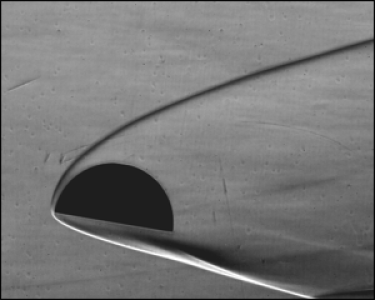Aerodynamic of Hypervelocity Bodies
Programme
GSTP
Programme Reference
G614-009MP
Prime Contractor
VON KARMAN INSTITUTE
Start Date
End Date
Status
Closed
Country
Belgium

Objectives
The objective of this activity is to improve the knowledge of the aerodynamic of flight objects entering in a planetary atmosphere at speeds large beyond of that from LEO.
Description
ESA has long experience with LEO entry missions like Hermes, ARD, MSRO, and more recently EXPERT and IXV among others. Based on an experience of more than 4 decades of aerodynamic assessment, which have supported most of European space related projects, it is the opportunity to extend the prediction capability to the upper range of the hypersonic, the hypervelocity, to adapt the European Industry to the need of future missions and events.
To achieve these objectives, investigations for a better characterisation of the real gas effects using different gases at different test conditions in terms of Mach and Reynolds numbers shall be performed. A better understanding of the flow phenomena shall be performed with dedicated physical modelling, specific numerical methods and dedicated test campaigns. Emphasis shall be given to themeasurement technique. New measurement techniques shall be employed toobtain an accurate flow characterization and to achieve reference test environments for quality database.
The following activities shall be performed:
- Improve the quality of the experimental data by reducing the amount of particles seeding the flow and ensure the flow establishment. Very high frequency measurements shall be performed both in the free-stream and along test models to provide details about the flow characteristics. New investigations are necessary to consolidate higher Mach number conditions (M 14) and lower Mach numbers (M 8-10). Also, the instrumentation capabilities shall be extended in order to better characterize the flow and the measurements on test models, allowing highly time resolved and accurate heat fluxes, pressures and forces. The existing flow visualization capabilities shall be enhanced allowing for detailed and instantaneous characterization revealing the flow structures and permitting the entire bandwidth of the sensors employed be exploited.
- Ensure better repeatability of the experiments and comparison with CFD modelling. Computations to model the experiment aiming at predicting initial conditions are required to obtain desired test flow quantities. The characterization of the flow shall be improved to assess the behaviour of the high pressure and high temperature gas used. An accurate qualification of the flow involved in the experimental investigation shall be obtained, thus allowing for better data analysis and reduced uncertainties on aerothermodynamic databases.
Application Domain
Space Transportation
Technology Domain
18 - Fluid Dynamics
Competence Domain
7-Propulsion, Space Transportation and Re-entry Vehicles
Initial TRL
TRL 4
Target TRL
TRL 6
Public Document
Executive Summary
Final Presentation
